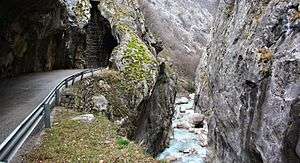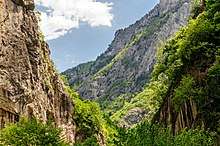Rugova Canyon
Rugova Canyon or Rugova Gorge (Albanian: Gryka e Rugovës; Serbian: Руговска клисура, romanized: Rugovska klisura) is a river canyon near Peć in Western Kosovo[lower-alpha 1], in the Prokletije mountains, close to the border with Montenegro. With a length of 25 km (16 mi) and a depth up to 1,000 meters, Rugova is considered to be one of Europe's longest and deepest canyons. It was created by water erosion and the retreat of the Peć glacier. The Peć Bistrica river cuts through the canyon.[1]
| Rugova Canyon | |
|---|---|
 Rugova Canyon and Peć Bistrica river in the right | |
| Location | Kosovo[lower-alpha 1] |
| Nearest city | Peć |
| Coordinates | 42°41′32″N 20°10′07″E |
| Area | 4.301,05,49 ha |
| Established | 1985 |
In 1985, Rugova Canyon was declared a protected monument of natural heritage due to its geological, hydrological, speleological and botanic values and its spectacular landscape.[2][3]
Geography

The canyon starts to narrow about three kilometres from Peć and continues to narrow for the next six kilometres, creating a steep valley which the river of Peć Bistrica flows through. It narrows again in an outfall along the western road of the region connecting Kosovo with Montenegro.[4] The average depth of the valley is 650-1000 meters. The canyon is inhabited on its east side and also on its west side during the summer months.
There are a few waterfalls and many water-springs, such Uji i Zi (Black Water) and Kroi i km-5 (5-th Km Spring). In the sixth kilometer of the canyon there is a 25-meter-high (82 ft) waterfall that springs out from the cliffs on its southern side and drops to the river. Many hundreds of caves are to be found in the gorge with most of them still unexplored. Well known caves include Gryka e Madhe (the Great Canyon-cave system; which has around 11km explored), Shpella e Karamakazit (Black Scissors cave) and Shpella e Kallabes (Kallaba Cave; where the archaeological remains of ancient humans have been found). A well known arch bridge connects the canyon, in front of which is a rock with a drawing of an athlete that is thought to be from the Pelasgian period.[5]
Gryka e Madhe Cave
The Gryka e Madhe (Great Canyon-cave) is located in the 8th kilometer of Rugova Canyon, in the left side, about 60 m above the Lumbardhi river, in the altitude 637 m.
Research in this cave started in 1993 when it was discovered in by Slovak speleologists who were traveling to Macedonia through the Rugova canyon. However, the cave was long known to local inhabitants before this. It has been identified that the cave's corridors are an oval profile, and it has the character of a continuously underground canyon with high walls. The highest levels of the cave do not have sediments, whilst the lower levels contain large, circular shaped rocks. Five levels of the cave have so far been explored. The first is at river level, which is 66 meters deep starting from its entrance. Different coloured sediments have been identified at this level. Due to its rough terrain and the high risk to people inside, the cave is rarely entered and is in a good state. Different teams of experts from Slovakia, Bulgaria, the NGO "Aragoniti" and KEPA have researched the cave.[6]
Attractions
Rugova Canyon offers great opportunities for hikers, rock-climbers and cave explorers. A "Via Ferrata", called the "Iron Trail", has been built. It is the first and the only one in the Balkans and enables hikers to climb rocks.[7] The Patriarchate of Peć, the historical and spiritual seat of the Serbian Orthodox Church, is located at the entrance of the canyon.
See also
- Rugova Mountains
- Rugovo (sword dance)
References
- Kosovo is the subject of a territorial dispute between the Republic of Kosovo and the Republic of Serbia. The Republic of Kosovo unilaterally declared independence on 17 February 2008, but Serbia continues to claim it as part of its own sovereign territory. The two governments began to normalise relations in 2013, as part of the 2013 Brussels Agreement. Kosovo is currently recognized as an independent state by 97 out of the 193 United Nations member states. In total, 112 UN member states recognized Kosovo at some point, of which 15 later withdrew their recognition.
- https://kk.rks-gov.net/peje/Municipality-(1).aspx?lang=sq-AL
- http://www.ammk-rks.net/repository/docs/1StateofNature.pdf
- http://www.ammk-rks.net/repository/docs/Hidromonumentet_e_mbrojtura_ne_Kosove.pdf
- http://www.pejatourism.org/pdf/informatori-turistik.pdf
- https://en.wikivoyage.org/wiki/Peja
- http://www.ammk-rks.net/repository/docs/1StateofNature.pdf
- http://www.telegrafi.com/lajme/udhetimi-ne-shtegun-e-hekurt-video-2-37361.html. Missing or empty
|title=(help)
| Wikimedia Commons has media related to Rugova Canyon. |
